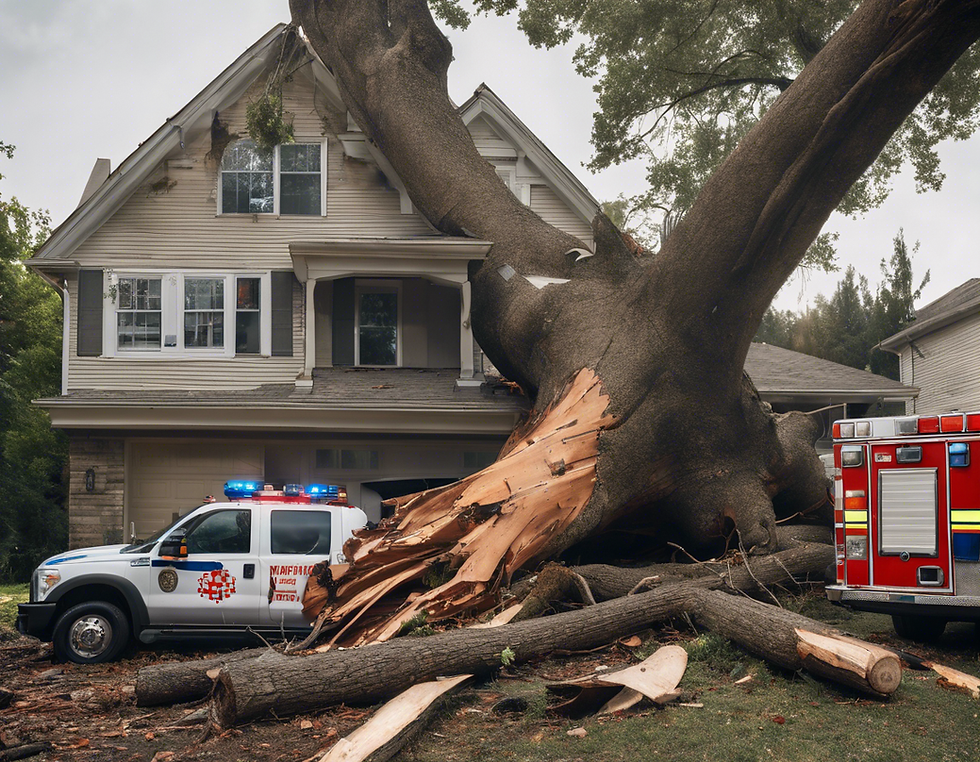Lyons Tree Service Redding: Understanding the signs of tree distress
- Joseph Lyons
- Nov 19, 2024
- 4 min read
Understanding the signs of tree distress is important for maintaining a healthy landscape and preventing further damage. Trees, like any living organisms, show signs when they are struggling. Early detection can help save a tree or prevent issues from spreading to other plants in your yard. Here are some common signs of tree distress:
1. Leaf Issues
Yellowing Leaves (Chlorosis): If the leaves turn yellow, it can indicate a variety of issues, such as nutrient deficiencies, water stress, or a fungal or bacterial infection. Chlorosis often affects older leaves first.
Wilting or Drooping: Leaves that are wilting or drooping, especially when there's no obvious water deficit, can indicate root damage, a pest infestation, or environmental stress.
Premature Leaf Drop: If leaves fall off early, it could be due to drought stress, disease, pest damage, or root problems. A tree shedding its leaves out of season might also be a sign of an underlying issue.
Spots or Discoloration: Dark spots, blotches, or streaks on leaves may be a sign of fungal or bacterial infections. Look for signs of rust, mildew, or mold.
2. Tree Trunk and Bark Problems
Cracks and Splits: Large, deep cracks or splits in the bark can be a sign of physical injury, disease, or stress. They may also allow pests or pathogens to enter the tree, worsening the problem.
Excessive Sap or Resin: Continuous leaking of sap or resin from cracks or wounds can indicate that the tree is stressed or has an infection.
Fungal Growth: Fungi growing on or around the tree's trunk or base could be a sign of decay or infection, especially if the fungus is persistent and spreading.
Peeling Bark: Peeling or curling bark can indicate a number of issues, from disease and pests to environmental stress.
3. Pests and Insects
Boring Holes: Small holes in the bark or trunk can be a sign of boring insects, such as beetles or termites. These pests can weaken the tree’s structure over time.
Visible Pests: The presence of insects such as aphids, caterpillars, or scale insects, particularly in high numbers, can stress the tree. These pests can damage leaves, stems, and roots.
Ants: Ants are often associated with sap-producing insects (like aphids), but they can also be an indication that the tree’s health is compromised, as ants might build nests in weakened trees.
4. Discoloration or Fungus on the Roots
Root Rot: A tree with root rot may exhibit wilting, yellowing leaves, and an overall decline in health. Root rot is often caused by overwatering or poor drainage, and it can cause a tree to die if left untreated.
Mushrooms or Fungi at the Base: Mushrooms or other types of fungal growth around the base of the tree often signal root rot or internal decay. This can compromise the tree’s structural integrity.
5. Unusual Growth Patterns
Stunted Growth: If a tree is growing slowly or has abnormal growth (such as small leaves or sparse branches), it could be a sign of stress from nutrient deficiencies, disease, or poor soil conditions.
Excessive Leaning: If a tree starts leaning more than usual or showing signs of uneven growth, it might indicate structural issues with the root system, such as root rot or damage.
6. Abnormal Leaf Shape or Size
Deformed or Distorted Leaves: Leaves that are curled, misshapen, or have strange growth patterns can indicate a pest problem or environmental stress.
Small or Sparse Leaves: Smaller-than-usual leaves or reduced leaf density can point to poor soil conditions, nutrient deficiencies, or a pest infestation.
7. Root and Soil Symptoms
Exposed Roots: Roots that become exposed above ground or that are visibly damaged can be a sign of soil erosion, drought stress, or root damage.
Soil Heaving: If the soil around the tree's root system appears to be heaving or lifting, it could indicate root instability or a weakening root system.
Water Stress: Overwatering or underwatering can cause visible signs of distress, such as dry, brittle leaves or soggy soil. Ensure the tree is receiving the appropriate amount of water for its species and environment.
8. Overall Tree Decline
General Decline: A tree showing signs of overall decline, like sparse canopy, poor leaf color, and visible damage, is often a sign of a deep-rooted problem. This could be caused by root disease, drought stress, pest infestations, or other long-term issues.
9. Cracking or Falling Fruit
If a fruit tree produces fruit that is prematurely cracking, shriveling, or falling off, it can be a sign of stress, often related to water inconsistency, pest problems, or diseases.
What to Do:
Diagnose the Problem: Start by identifying what’s causing the distress. A certified arborist or tree care professional can help diagnose serious issues like root rot, fungal infections, or pest infestations.
Proper Care: Ensure the tree gets proper care, including watering, fertilization, pruning, and mulching. Avoid overwatering, as it can lead to root rot, and ensure the tree is not subject to lawnmower or foot traffic damage.
Pest Control: If insects or pests are found, consider applying eco-friendly pest control methods or hiring a professional.
Pruning: Prune dead or diseased branches to prevent further spread of disease and pests. Be sure to prune at the right time of year and follow proper pruning techniques.
Soil Health: Ensure the soil has adequate drainage and nutrients. Consider testing your soil to determine if there are any deficiencies or imbalances.
Consult a Professional: If the tree appears to be severely distressed, consulting a certified arborist may be the best option for treatment and care recommendations.



Comments